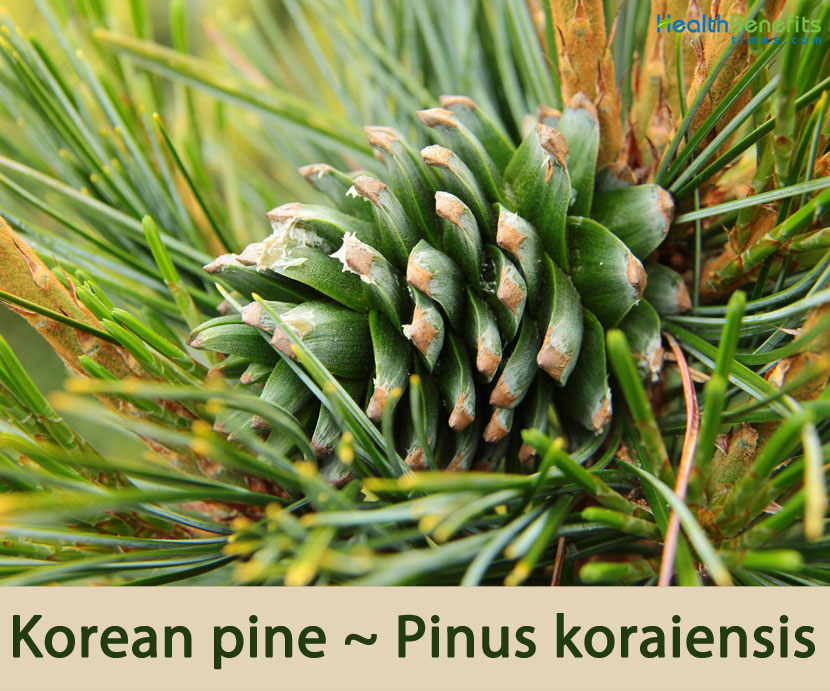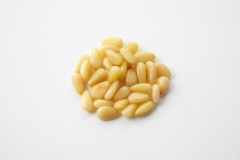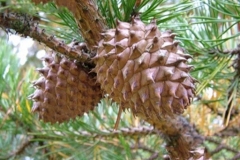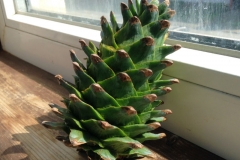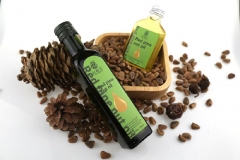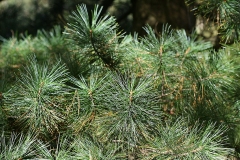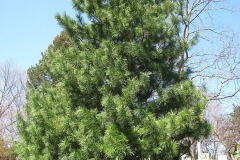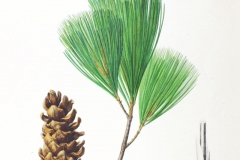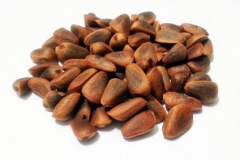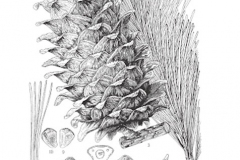| Korean pine Quick Facts | |
|---|---|
| Name: | Korean pine |
| Scientific Name: | Pinus koraiensis |
| Origin | Eastern Asia: Manchuria (Ussuri River basin) in northeast China, Mongolia, Primorsky Krai and Khabarovsk Krai in the far east of Russia, Korea and Japan |
| Colors | Green when young turning to brown as they mature (Cone) |
| Shapes | They are ovoid or cylindrical-ovoid in shape, 3.5 to 4.5 inches (9 - 11 cm) long and 2 to 2.5 inches (5 - 6 cm) broad. (Cone) |
| Taste | Extremely crunchy having a salty taste |
| Health benefits | Support earache, epitasis, cough, cold, influenza, kidney and bladder complaints, skin complaints, wounds, sores, burns and boils |
| Name | Korean pine |
|---|---|
| Scientific Name | Pinus koraiensis |
| Native | Eastern Asia: Manchuria (Ussuri River basin) in northeast China, Mongolia, Primorsky Krai and Khabarovsk Krai in the far east of Russia, Korea and Japan -Honshu southward from Tochigi Prefecture and northward from Gifu Prefecture, and Shikoku |
| Common Names | Cedar Pine, Chinese Pinenut, Hinggan Red Pine, Korean Cedar, Korean Pine, Korean Pinenut, White Pine, sea pine, Siberian yellow pine |
| Name in Other Languages | Arabic: Sanawbar kuriun (صنوبر كوري) Bulgarian: Koreĭski kedrov bor (корейски кедров бор Catalan : Pi De Corea Chinese : Chao Xian Song (朝鲜松), Guo Song, Hai Song, Hai Sung, Han Song, Hong Guo Song, Hong Song (红松), Hung Song, xin luo song zi, Hai song (海 松), Guo song (果松), Han song (韩松), Hóngguǒ sōng (红果松), Chao xian song (朝鲜松 ) Czech : Borovice Korejská Danish : Koreafyr Dutch: Koreaanse pijn Estonian : Korea Seedermänd English: Chinese pinenut, Korean pine, Korean nut pine, sea pine, Siberian yellow pine, white pine Finnish : Koreansembra French : Pin De Corée, pin de Koréa, pin de ore, Pin blanc de Corée German : Korea-Kiefer Hungarian : Koreai Fenyõ, Koreai cirbolya Icelandic : Kóreufura Italian : Pignoli, Pinoli, Pino coreano, Pino de Corea Japanese: Chosenmatsu, Chosen-Goya, Chousen Goyou Matsu, Minimatsu, Chousen goyou (チョウセンゴヨウ), Chousen goyou matsu (チョウセンゴ ヨウマツ ), Chousen matsu (チョウセンマツ), Chiusengoyou (チウセンゴヨウ) Komi: Korejaisʹ suspu (Кореяись суспу) Korean : Channamu, Jatnamu, jasnamu (잣나무) Mongolian: Solongos nars (Солонгос нарс) Netherlands: Koreaanse Pijn Norwegian: Koreafuru Persian : کاج کرهای Polish : Sosna Koreańska Portuguese: pinheiro-da-Coreia Russian: Korejskij kedr (Корейский кедр), sosna korejskaya (Сосна корейская), koreyskiy kedr (корейский кедр), man’chzhurskiy kedr (маньчжурский кедр), sosna kedrovaya koreyskaya (сосна кедровая корейская) Slovakian : Borovica Kórejská Spanish : Pino De Corea, Piñón Swedish : Koreansk Tall, Koreatall Taiwan : Hai Song Tatar: Кәрия эрбете Turkish : Kore Çamı Udmurt: Koreyays’ kedr (Кореяысь кедр) Vietnamese: Thông Triều Tiên |
| Plant Growth Habit | Tall, large, branched, pyramidal, monoecious, evergreen tree |
| Growing Climates | Dry mountain slopes, especially those facing north |
| Soil | Prefer growing in moist, sandy to sandy loam soil with adequate drainage in full sun. The plant grows well in both sandy and clay soils. Avoid poorly-drained wet soil |
| Plant Size | 30 m (100 ft.) in height with a trunk up to 60 inches (150 cm) in diameter at breast height. Cultivated specimens may grow up to 15 m (50 ft.) tall |
| Branchlets | Branchlets densely red-brown, occasionally yellow pubescent |
| Bark | Bark is gray-brown and smooth when young becoming gray-black, scaly, and peeling on larger trees to reveal reddish inner bark |
| Winter Buds | Winter buds reddish brown, oblong-ovoid, slightly resinous |
| Leaf | Borne in fascicles of 5 at the end of a short shoot, 2.5 to 5 inches (6 – 13 cm) long and 0.06 inch (1 mm) wide, triangular in transverse section, dark green on outer face, with two inner faces that are whitish green with stomata |
| Flowering season | May |
| Cone Shape & Size | Solitary or several clustered near the ends of new shoots. They are ovoid or cylindrical-ovoid in shape, 3.5 to 4.5 inches (9 – 11 cm) long and 2 to 2.5 inches (5 – 6 cm) broad |
| Cone Color | Green when young turning to brown as they mature |
| Seed | Triangular obovoid, large, 12–16 mm long by 10 mm wide and 7 mm thick, with a hard seed coat covering a glossy yellowish kernel |
| Taste | Extremely crunchy having a salty taste |
| Plant Parts Used | Seeds, leaves, nuts, bark, and resin |
| Propagation | By Seed, cultivars grafted |
| Season | September |
Plant Description
Korean pine is a tall, large, branched, pyramidal, monoecious, evergreen tree. In its native habitat and growing conditions it can reach 30 m (100 ft.) in height with a trunk up to 60 inches (150 cm) in diameter at breast height. Cultivated specimens may grow up to 15 m (50 ft.) tall. Plant is found growing in dry mountain slopes, especially those facing north direction. The plant prefers growing in moist, sandy to sandy loam soil with adequate drainage in full sun. The plant grows well in both sandy and clay soils. Avoid poorly-drained wet soil. When young, this tree typically grows in a narrow pyramidal form with ascending branching. With age, it relaxes into a loose pyramidal shape with a rounded crown and branching that is almost horizontal. Branching on mature trees usually extends to the ground. Bark is gray-brown and smooth when young becoming gray-black, scaly, and peeling on larger trees to reveal reddish inner bark. The branchlets are densely red-brown, occasionally yellow pubescent. Winter buds are reddish brown, oblong-ovoid and slightly resinous.
Leaves
Needles (Leaves) are borne in fascicles of 5 at the end of a short shoot, 2.5 to 5 inches (6 – 13 cm) long and 0.06 inch (1 mm) wide, triangular in transverse section, dark green on outer face, with two inner faces that are whitish green with stomata.
Cones
Pollen cones are ellipsoid in shape and develop crowded at base of new shoots. Seed cones are solitary or several clustered near the ends of new shoots in groups of 1 to 5. Cone lets are green in color and ovoid in shape. They develop on a short peduncle and are green in color ovoid or cylindrical-ovoid in shape, 3.5 to 4.5 inches (9 – 11 cm) long and 2 to 2.5 inches (5 – 6 cm) broad. Scales are woody, broadly rhomboid, about 2.5 cm long and wide, green on upper half, brown on lower half, apex with recurved spiny boss.
Seeds
Seeds are large, thickly, triangular obovoid in shape, wingless, 12–16 mm long, 10 mm wide and 7 mm thick, with a hard seed coat covering a glossy yellowish kernel. Trees start flowering from May, with cones maturing in October of the following year.
Traditional uses and benefits of Korean pine
- Turpentine obtained from the resin of the trees is antiseptic, diuretic, rubefacient and vermifuge.
- Externally it is a very beneficial in the treatment for a variety of skin complaints, wounds, sores, burns, boils etc. and is used in the form of liniment plasters, poultices, herbal steam baths and inhalers.
- Stem bark is used for treating burns and skin ailments.
- Seed consists of several medically active compounds and is analgesic, antibacterial and anti-inflammatory.
- It is a valuable remedy used internally in the treatment of kidney and bladder complaints and is used both internally and as a rub and steam bath in the treatment of rheumatic affections.
- It is also very beneficial to the respiratory system and so is useful in treating diseases of the mucous membranes and respiratory complaints such as coughs, colds, influenza and TB.
- People take Korean pine nut by mouth for earaches, nosebleeds, and to increase milk production during breastfeeding in Korea.
- Korean pine nut oil is taken by mouth for weight loss.
- People apply Korean pine stem bark or Korean pine tree resin as a plaster, poultice, or steam bath for burns, sores, boils, and other skin wounds.
- Those suffering from skin problems are recommended by the doctors to have these nuts daily before their morning breakfast.
- It is also beneficial for the respiratory system.
Culinary Uses
- Shelled pine nuts have been eaten in Europe and Asia for a long time.
- They are also a source of dietary fiber.
- Pine nuts are frequently added to meat, fish, and vegetable dishes.
- They constituted an essential ingredient of pesto sauce.
- They are widely used in the cuisine of southwestern France, in dishes such as the salade landaise.
- They are also used in chocolates and desserts such as baklava.
- In New Mexico in the southwest United States, pine nut coffee a typically dark roast coffee having a deep, nutty flavor is a specialty and is made from roasted and lightly salted pine nuts.
- Pine nuts are also a widely used ingredient in a diverse range of Middle Eastern cuisine, such as kibbeh, sambusek, ladies’ fingers and many other dishes.
- In Korea, pine nuts are used for making rice biscuits and sweets.
- Seeds can also be dried and ground into a powder then used as a flavoring and thickener in soups.
- The green cones are used for making wine.
- Seed can be consumed raw or cooked.
- It has a soft texture with a hint of resin in the flavor; it makes a delicious snack and can also be used as a staple food.
- A vanillin flavoring is obtained as a by-product of other resins that are released from the pulpwood.
- These nuts are frequently added to the sweetmeat called pignoli. Pignoli cookies, an Italian confection is made of almond flour formed into dough and then topped with pine nuts.
- Pine nuts are used in Middle Eastern cuisine as well.
https://www.youtube.com/watch?v=LLXFXuQGKn4
Other Facts
- Besides being cultivated for pine seed harvest, it is widely used in reforestation programs.
- In Europe and North America it is planted as ornamental.
- The timber is used for construction, carpentry, bridge building, vehicles, furniture, and wood pulp.
- Seeds besides being edible and medicinal, are used as a source of soap and lubricating oil.
- Turpentine is obtained from the timber and roots.
- Turpentine has a wide range of uses including as a solvent for waxes etc., for making varnish and rosin the substance left after turpentine is removed is used by violinists on their bows.
- The bark yields tannin; the trunk yields resin and gum.
- A tan or green dye is obtained from the needles (leaves).
- The resins are obtained by tapping the trunk, or by destructive distillation of the wood.
- This is used by violinists on their bows and also in making sealing wax, varnish etc.
- Pitch can also be obtained from the resin and is used for waterproofing, as a wood preservative etc.
- The Korean pine is used as an ornamental tree.
- It is used for a great variety of products, including telephone poles, railroad ties, bridges, boats, plywood and flooring, furniture, sports equipment, and musical instruments.
- It is easy to break down into chips, particle board, or pulp for paper.
- Korean pine starts producing large amounts of nuts when it reaches 100 years.
- One tree could yield up to 20 kilos, which collectively comes to almost one ton of nuts per hectare of a Korean pine.
Precautions
- The wood, sawdust and resins from various species of pine can cause dermatitis in sensitive people.
- Korean pine nut oil might affect blood pressure control in people who have blood pressure that is too high or too low.
- Korean pine nut might cause allergic reactions in some people. People who are sensitive to similar plants should avoid Korean pine nut.
- Sometimes over consumption of these nuts can cause taste disturbances.
References:
https://www.itis.gov/servlet/SingleRpt/SingleRpt?search_topic=TSN&search_value=822554#null
https://npgsweb.ars-grin.gov/gringlobal/taxon/taxonomydetail?id=28463
https://pfaf.org/user/Plant.aspx?LatinName=Pinus+koraiensis
https://www.missouribotanicalgarden.org/PlantFinder/PlantFinderDetails.aspx?taxonid=284965
https://www.cabi.org/isc/datasheet/41633
https://gd.eppo.int/taxon/PIUKO
http://www.theplantlist.org/tpl1.1/record/kew-2561659
https://en.wikipedia.org/wiki/Pinus_koraiensis
https://plants.usda.gov/home/plantProfile?symbol=PIKO2


